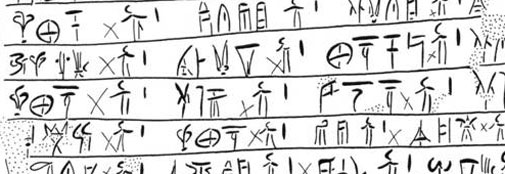Terminologies of Textiles

Linear B
In Textile Terminologies in the 3rd and 2nd millennia BC we cooperated with philologists and linguists and experts in various languages (and scripts) of the 3rd and 2nd mill. BC. Textile terminology was in need of more clear-cut definitions, without which further classification was useless. We initiated a theoretical discussion of textile classification according to terminological systems based on use, technique or fibre and a concrete identification of the textile terminology, and we addressed the problems concerning translations of textile terms from language to language. The goal was to test the degree of standardisation in Bronze Age societies, and the degree of standardised textile terminology.
The written sources from the Ancient Near East and the Eastern Mediterranean Area from the 3rd to the 1st millennium contain rich terminologies describing textiles. The survey of textile terminologies demonstrates the interconnections between languages and cultures via textiles: The Greek word for a long shirt, khiton, ki-to in Linear B, derives from the Semitic root ktn. The Akkadian term for linen is kitûm, but the Old Assyrian kutānum is made of wool and the Arab and English word for cotton today has the same root. This example illustrates on the one hand how connected some textiles terms are across time and space, but it also shows how very carefully we must conduct the etymological and terminological enquiry with constantly changing semantics as the common thread.
Collaborators
Collaborators:
Anne-Claude Beaugeard, Paris
Maria Giovanna Biga, Università di Roma "La Sapienza", IT
Catherine Breniquet, Université Blaise-Pascal, Clermont-Ferrand II
Maurizio del Freo, Università di Roma "La Sapienza", IT,
Sophie Desrosiers, Ecole des Hautes Etudes en Sciences Sociales, Paris, France
Pascaline Dury, Centre de Recherche en Terminologie et Traduction, Université Lyon 2, FR
Benjamin Foster, Yale University, USA
Ole Herslund, University of Copenhagen, DK
Francis Joannès, Université de Paris I Panthéon – Sorbonne, Maison de l’archéologie et de l’ethnologie, Nanterre, FR
Jana Jones, Macquarie University, Australia
Robert Laffineur, Université de Liège, Belgium
Agnete Wisti Lassen, University of Copenhagen, DK
Susanne Lervad, Termplus Aps, Danterm, Denmark
Eugenio Luján, Universidad Complutense de Madrid, ES
Cécile Michel, CNRS, Maison de l’archéologie et de l’ethnologie, Nanterre, France
Jacopo Pasquali, Università di Firenze, IT
Franco Pomponio, Università de Messina, IT
Miguel Ángel Andrés-Toledo, University Salamanca, ES
Françoise Rougemont, CNRS, Maison de l’archéologie et de l’ethnologie, Nanterre, FR
Lorenzo Verderame, University of Rome, Italy
Matteo Vigo, Università degli Study di Pavia
Pierre Villard, Université Blaise-Pascal, Clermont-Ferrand II
Juan-Pablo Vita, CSIC Instituto des Estudios Islámicos y del Oriente Próximo, Zaragoza, Spain
Hartmut Waetzoldt, Ruprecht-Karls Universität Heidelberg, DE
Stefan Zawadzki, Adam Mickiewicz University Poznan, PL
Selected publications :
Textile Terminologies from the 3rd to the 1st mill. BC in the Ancient Near East and the Eastern Mediterranean Area, edited by Cécile Michel & Marie-Louise Nosch, Ancient Textiles Series 8, Oxbow Books 2010.
Appearances
Professor Marie-Louise Nosch appears in CNR annual report:
"Ardiadne's thread: aspects of the Mycenean textile terminology"
"Textile Terminologies in the Ancient Near East and Mediterranean from the Third to the First Millennia BC."
Review of the anthology by Carol Bier, The Textile Museum, Washington, DC
